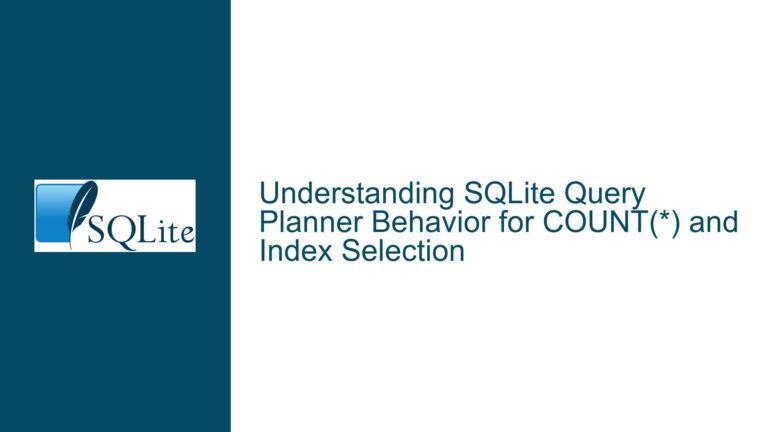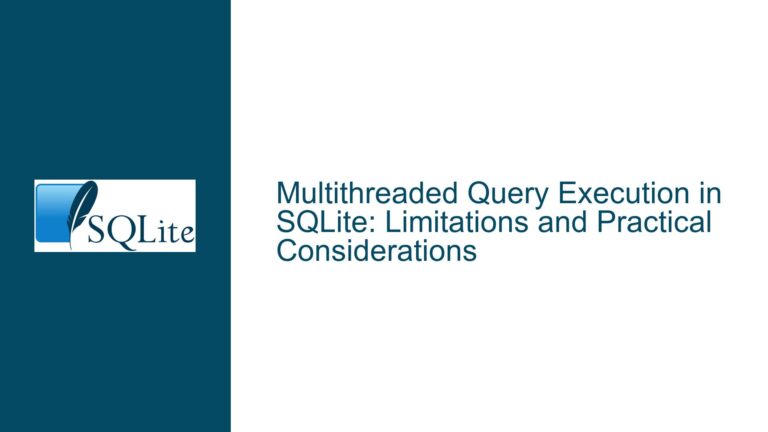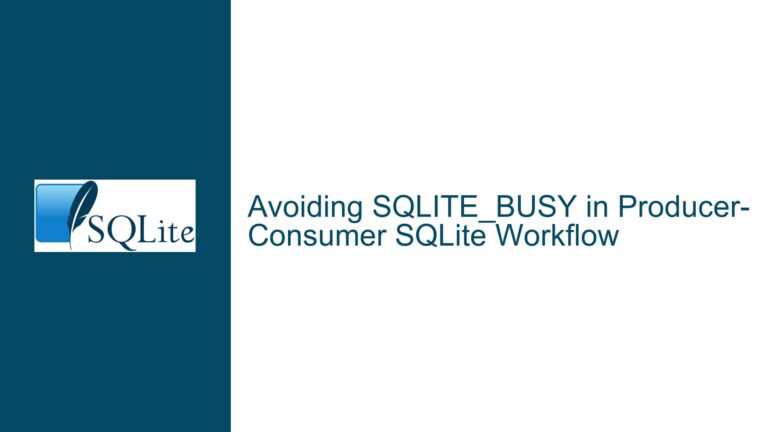Optimizing SQLite Blob Storage to Minimize Unused Page Space
Understanding SQLite’s Page Allocation and Blob Storage Overhead
Key Components of SQLite’s Storage Architecture
SQLite organizes data into fixed-size pages (default 4KB), managed through B-tree structures for tables and indexes. Each page contains payload data (user content), metadata (pointers, headers), and free space. When inserting blobs, SQLite attempts to fit them into contiguous pages. However, if a blob exceeds the remaining space on a partially filled page, SQLite allocates a new page, leaving the original page’s free space unused. This behavior prioritizes read/write efficiency over storage density.
For blobs larger than a page minus metadata overhead, SQLite uses overflow pages. Each overflow chain introduces additional page headers and pointers, compounding wasted space. The sqlite3_analyzer tool quantifies this as "unused bytes," which includes both intra-page gaps and overflow page overhead. In scenarios where blobs vary widely in size (100B–1MB+), the database may exhibit up to 15–17% unused space due to suboptimal page packing and frequent overflow allocations.
Impact of Write-Once, Read-Many Workloads
In write-once scenarios, traditional space-reclamation strategies like auto-vacuuming or manual VACUUM commands are ineffective. Auto-vacuum removes free pages but does not repack partially filled pages. Manual VACUUM rewrites the database into a new file with minimal free space, but for blobs, this process often fails to eliminate intra-page gaps because SQLite’s B-tree structure inherently reserves space for future insertions.
Factors Contributing to Suboptimal Blob Storage Density
Page Size Mismatch and Overflow Page Proliferation
Choosing an inappropriate page size amplifies unused space. For example, a 4KB page size with 4040B blob chunks leaves 8B per page unused (excluding metadata). At scale, this accumulates to megabytes of waste. Larger page sizes (e.g., 8KB) reduce overflow frequency but increase internal fragmentation for smaller blobs. Overflow chains further degrade efficiency by introducing page headers (8–12 bytes per overflow page) and fragmenting blob storage across non-contiguous pages.
B-Tree Node Fill Factor and Rowid Management
SQLite’s B-trees aim for a balance between node density and insertion speed. Each table row (including blobs) is associated with a rowid, which influences page layout. When blobs are inserted with explicit rowid assignments, SQLite may leave gaps in earlier pages to accommodate future rowid-ordered inserts. Without INTEGER PRIMARY KEY declarations, these gaps persist indefinitely.
Metadata Overhead and Cell Pointer Arrays
Each page maintains a cell pointer array to locate rows within the page. For tables with many small blobs, this array consumes a significant portion of the page, reducing available payload space. For instance, a page storing 100 blobs reserves ~2 bytes per cell pointer (200 bytes total), leaving less room for blob data.
Strategies for Maximizing Blob Storage Efficiency
Schema and Page Size Optimization
Match Page Size to Blob Chunking Strategy
- Determine the median blob size and set the page size to a multiple slightly larger than this value. For 1MB blobs, use
PRAGMA page_size=65536(64KB) to minimize overflow pages. - Pre-split blobs into chunks aligned to
page_size - metadata. For a 64KB page, use 65536 – 40 = 65504B chunks (40B reserved for cell pointers, headers).
- Determine the median blob size and set the page size to a multiple slightly larger than this value. For 1MB blobs, use
Leverage
WITHOUT ROWIDTables- Convert tables to
WITHOUT ROWIDformat if blobs are accessed via a composite primary key. This eliminates therowidcolumn, saving 8 bytes per row and improving page density.
- Convert tables to
Use
INTEGER PRIMARY KEYfor Implicit Rowid Recycling- Declare an
INTEGER PRIMARY KEYcolumn to reuse deletedrowidslots, reducing gaps in B-tree pages.
- Declare an
Advanced Blob Insertion Techniques
Proactive Free Space Calculation via
dbstatVirtual Table- Query the
dbstatvirtual table to identify pages with free space:SELECT pgno, freeblock, nfree FROM dbstat WHERE name='blob_table'; - Develop a script to calculate remaining space per page and split incoming blobs to fill these gaps.
- Query the
Direct Page Manipulation with
sqlite3_blobAPI- Use
sqlite3_blob_open()andsqlite3_blob_write()to write pre-chunked blobs into specific rows, avoiding SQL query parsing overhead. Combine withdbstatqueries to target underfilled pages.
- Use
Appendvfs for Hybrid Storage
- Store raw blobs in a flat file, then append a SQLite database using the appendvfs extension. The SQLite layer contains metadata (offsets, checksums), while the flat file ensures 0% wasted space.
Post-Insertion Compaction and Alternatives
Custom Vacuuming with
sqlite3_serialize()- Serialize the database to an in-memory buffer using
sqlite3_serialize(), then write it to a new file. This bypasses SQLite’s page reuse logic, producing a denser file.
- Serialize the database to an in-memory buffer using
Columnar Blob Concatenation
- Store all blobs in a single row using incremental
INSERTwithRETURNINGto track offsets:INSERT INTO blob_store (data) VALUES (?) RETURNING length(data); - This approach eliminates inter-blob gaps but complicates random access.
- Store all blobs in a single row using incremental
SQLAR-Based Archiving
- Adopt the SQL Archive Format, which combines SQLite metadata with compressed/uncompressed blobs. While designed for compression, it can store pre-compressed blobs with minimal overhead.
Critical Evaluation of SQLite’s Suitability
For applications requiring near-100% storage efficiency, SQLite may not be optimal. Alternatives include:
- Custom Binary Formats: Preallocate space for blobs with a header indexing offsets/sizes.
- Tar-like Formats: Use SQLite for metadata (filenames, timestamps) and external blobs in a concatenated file.
However, SQLite remains viable if the 10–15% overhead is acceptable for benefits like ACID compliance, random access, and cross-platform compatibility. Compressing the entire database with algorithms like Zstandard (zstd) can reduce transmitted size despite existing blob compression, as SQLite’s free space compresses trivially.
By aligning page sizes to blob chunks, leveraging dbstat for free space tracking, and employing strategic schema design, users can reduce SQLite’s storage overhead to 5–8%. For write-once workloads, combining sqlite3_serialize() with post-serialization trimming achieves near-optimal density, while hybrid approaches (appendvfs + flat files) eliminate overhead entirely at the cost of increased complexity.






